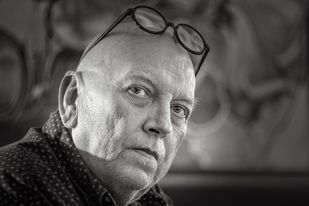Malcolm Wilson is a photographer, web designer, journalist, artist and all-around Renaissance man who makes it his business to put the humanity of Appalachia at the center of his work. He now lives in the mountains of Blackey, Kentucky but is originally from Cumberland, Kentucky in Harlan County, Kentucky. In the early 1980s, Wilson left the mountains to attend Northern Kentucky University majoring in Fine Arts (Photography) and minoring in journalism. Malcolm Wilson’s life and work brought him into the fold of the Urban Appalachian Council and the Appalachian Community Development Association, sponsor of the annual Appalachian Festival. With a new documentary film on his life and work, produced by the Behringer Crawford Museum, I took a few minutes to talk to Malcolm Wilson about his work.
If you attended the Appalachian Festival in Cincinnati there is a good chance you have seen the work of Malcolm Wilson. Wilson was involved in the Appalachian Festival for many years and was the Festival Chair for the 25th Festival. Coming here from Harlan County, Kentucky, Wilson remembered that “me and my wife felt lost. On weekends we would travel back home, and once we were there, we never wanted to leave.” But that feeling of being lost was alleviated as Wilson and his wife met up with the Appalachian community. Wilson met core members Pauletta Hansel and Maureen Sullivan, to name just two, and began to get his legs here in the city. These connections, and becoming active with the Urban Appalachian Council and ACDA, led Wilson to apply his gifts locally.
The “Perceptions of Home” exhibit was one major work that grew out of Malcolm Wilson’s involvement with UAC. This was a major work that involved photographs and interviews that told “the stories of displaced Appalachians who had moved to better their lives.” Explains Wilson, “the entire project addressed the perspectives of Appalachian people who had been displaced.” Don Carothers did the interviews to accompany Wilson’s photographs. The collection was displayed at the Appalachian Festival. It went on to win multiple awards and toured the country. The heart of this type of work, for Wilson, is telling individual stories. The people in these photographs are not objects, they are subjects with real history and real lives.
For Wilson, the art of photography is all about telling the stories of the people. Malcolm Wilson “makes photographs rather than takes photographs.” The point is that the images we finally see are the result of the personal connections he makes with people, and the images grow from these connections. The process of giving voice to individuals through the medium of photography finds one of its highest expressions in the “Humans of Central Appalachia” project. The online resource is the culmination of Malcolm Wilson’s work on the ground with the people of Appalachia. The work you find on the “Humans of Central Appalachia” is the culmination of Wilson’s work out in the communities. The site tells us that Wilson sets out for points unknown to gather the honest and compelling stories that are helping to shatter the generations-old stereotypes of Appalachians and our culture.” Malcolm told me, “every story is important historically, and that is why I work to relate these stories.” He captures all of this in word and image.
The Behringer-Crawford Museum recently produced a short documentary on Malcolm Wilson and his work. Here I am: Making Photographs with Malcolm Wilson was originally intended to be part of the FotoFocus biennial exhibit, but that was interrupted by the COVID-19 pandemic. The Behringer-Crawford Museum took it upon themselves to produce the documentary film that provides the story of Malcolm Wilson and the stories he brings to the world. This film offers interviews with Wilson in which he describes his beginnings in photography, a story that involves a rather messy calculus teacher and a teenaged Wilson paying attention to things other than calculus. It provides background into his early work and takes us to Wilson as he offers the backstory behind some of his work. We also get to meet the most photographed man in Appalachia. I’ll let you watch the film to get that story.
It is in the true style of Malcolm Wilson that the pandemic that shut down the FotoFocus exhibition became yet another story for him to tell. In collaboration with singer/story-teller Ron Short, the video-short “Masks, Quarantined in Appalachia” captures the immediacy of our current moment in history. Wilson’s images make for a video montage that is accompanied with music and spoken word from Short.
Malcolm Wilson remains deeply committed to the people of his home and the surrounding regions. His images tell their stories with the heart of one who takes the time to become a neighbor before he “makes” a photo of someone’s personal story. His ties to the Urban Appalachian Community Coalition reach back to the some of the earlier incarnations of urban Appalachian advocacy and community, and even in the midst of personal adversity, Malcolm Wilson remains one of the most powerful advocates of Appalachian people and culture.
You can also view Here I Am: My Appalachia, a portfolio of Malcolm Wilson’s work here: https://www.youtube.com/watch?v=OOfD7TFiOUg.
Mike Templeton is a writer, independent scholar, barista, cook, guitar player, and accidental jack-of-all-trades. Check out his profile in UACC’s new Cultural Directory. He lives in downtown Cincinnati with his wife who is a talented photographer. They spend their free time walking around the city snapping photos. She looks up at that the grandeur of the city, while Mike always seems to be staring at the ground.

